"The first quarter of the 19th century in France was a turbulent time. Napoleon had just been defeated, and the war between the Royalists and Republicans had begun anew with fresh vigor. Charles X, after an attempt to restore the absolutism of the old French monarchy and put an end to the freedom of press, had been forced to abdicate in the July Revolution of 1830. The “citizen-king” Louis-Philippe was elected to take his place. All this political turmoil, plus the new technique of lithography led to the birth of a new popular art form: the political caricature." [source]
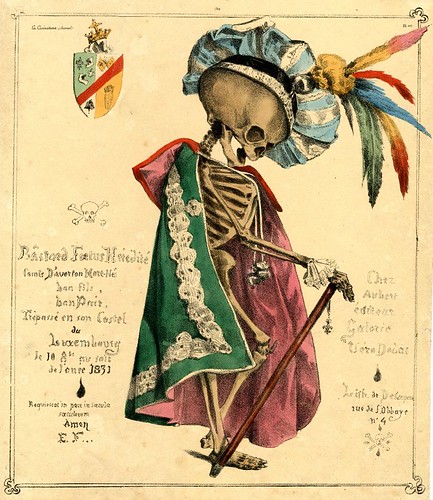
Bâstard Foetus Hérédité
'Bâstard Foetus Hérédité Comte D'Avorton Mort-Né bon fils, bon Pair, Trépassé en son Castel du Luxembourg le 10 8be au soir de l'anée 1831', 'Requiescat in pace in soecula saculorum Amen E.F....'
*(The bastard hereditary foetus (of?) the Count of Avorton, a still-born good son; the pair died in Luxembourg Castle [..] Rest in Peace for ever and ever
OR maybe:
Both the Count of Avorton and his still-born son, the bastard foetus of inheritance, died in Luxembourg Castle etc etc)*
[the gist is there, but if anyone has a better trans. please leave a comment]
Published on October 20, 1831 by Maison Aubert [Print made by Eugène Forest and printed by Delaporte]
The print represents a caricature of a Parisian peer. The coat of arms on the above left, is an example of 'armes parlantes' [where the visual elements evoke the name of the owner of the arms] and satirizes the Bourbon family. The French lilies and the flags decorated with lilies [not really viewable in this modest sized image], recall the governement of Charles X. Near the lilies, an upper and lower jaw and beneath a helmet decoration and a mummy. The text within the image acts as a text relating to the death of a peer, living in the castle of Luxembourg (the 'Palais du Luxembourg' was the seat of the Chamber of Peers). The main debate started in October 1831, when the members of Parliament discussed the inheritability of the Chamber of Peers.
[ultimately the peerage ceased to be hereditary; the Upper House that they staffed was abolished in 1848 and the peerage slowly died out] {italics - me}
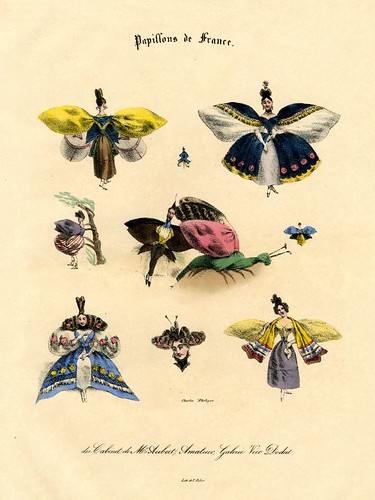
Papillons de France
Published by Maison Aubert (undated but probably early 1830s) [print made by Charles Philipon, printed by V Ratier]
{semi-related: Butterfly People}
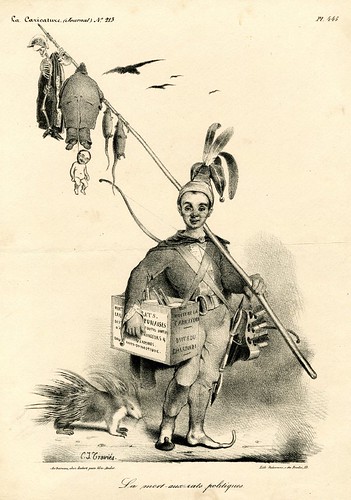
La Mort-aux-Rats Politiques
(Death of political rats)
Published by Maison Aubert, 1835 [Print made by Charles Joseph Traviès; printed by Delaunois]
The satirist as the political rat-catcher; from the publication 'La Caricature'.

Cabinet d'Histoire Naturelle
Published by Maison Aubert, 1833. {Print by JJ Grandville and Eugène Forest; printed by Becquet}
This satire is part of a series of representations inspired by the wunderkammer* or cabinet of curiosities, which Grandville applied to the politicians of Louis-Philippe's governement. The cabinet of natural history consists of several animals with human heads. Grandville had already employed the idea of satirizing human people with animals in one of his most successful series, 'Métamorphoses du Jour' from 1829. {see Tout le Monde Animée}
Also see: 'Le Buffon de l'Humanité : La Zoologie Politique de J.J. Grandville' {The Buffon* of Humanity: Political Zoology}, a long illustrated article on the background to Grandville's use of animals in satirical caricatures. [Trans.]
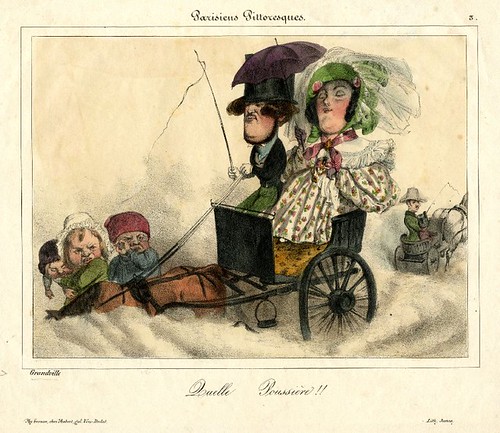
Quelle poussière!!
(What dust!!)
Published by Maison Aubert, 1835 [Print made by JJ Grandville; printed by Junca]
Satirical caricature of a bourgeois couple driving a cart. The man wearing a top hat and holding a whip, the woman holding an umbrella. All around them is dust; on the right in the background a cart and on the left three children in a cloud of dust looking at the couple with contempt.
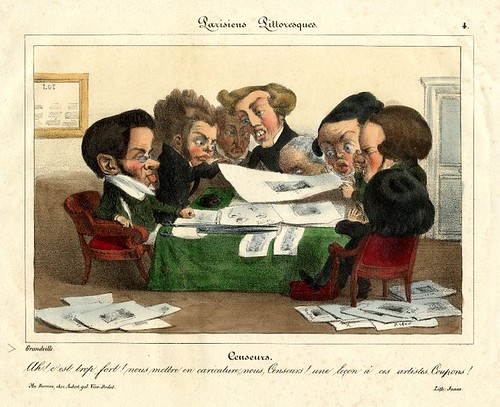
Censeurs
(Censors)
Published by Maison Aubert, 1835 [Print made by JJ Grandville; printed by Junca]
Both this illustration and the one above are from a series, 'Les Parisiens Pittoresques', published in the magazine, 'Le Charivari'.
Satirical caricature of a group of censors, sitting at a table and analysing different prints so they can decide which ones can be published.
See: Censorship in 19th Century France: Caricature vs. the Censor 1831 - 1832 at Great Caricatures.
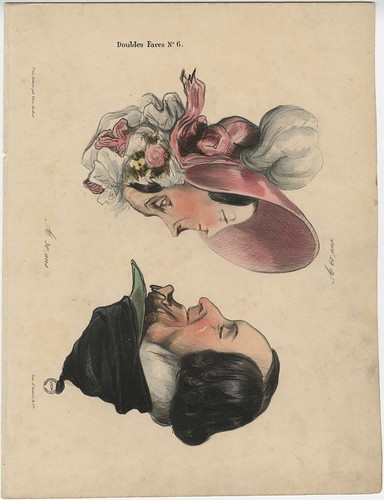
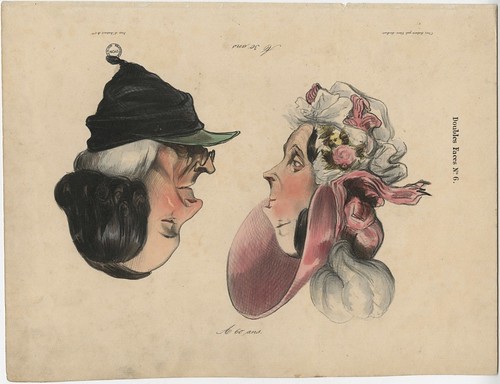
A 30 ans - A 60 ans
(At 30 & 60 years of age)
From a series of six prints called 'Doubles faces'.
Published by Maison Aubert in 1838 [Artist - Honoré Daumier]

"- Bertrand, j'adore l'industrie..... Si tu veux, nous avons une banque, mais là, une vraie banque! Capital cent millions de millions, cent milliards de milliards d'actions, Nous enfonçons la banque de France, nous enfonçons les banquiers, les banquistes nous enfonçons tout le monde!
- Oui, mais les gendarmes?
- que tu es bête Bertrand est-ce qu'on arrête un millionnaire?"
*- Bertrand, I love the industry....If you want, we'll create a bank, a real bank! It will have capital of millions and millions and we'll issue billions and billions of shares. We'll crush the Bank of France, we'll crush the bankers and the supporters of banks, we'll crush everybody!
- Yes, but what about the Police?
- Don't be silly Bertrand. Do millionaires go to jail? * {approximation}
Published by Maison Aubert in 1836 [Artist - Honoré Daumier]
Image spliced together from screencaps and sourced from FAMSF.
"Honoré Daumier's career extended from the first year of the July Monarchy to the early years of the Third Republic. It was Charles Philipon who first recognised Daumier's talent and brought him into the 'Charivari', writing the captions for his lithographs.
Daumier is well known for his satirical depictions of the lawyers, doctors, and other social types, but the series that best captures the spirit of the July Monarchy (and perhaps to some extent our own epoch) is the 'Caricaturana' ('Le Charivari', August 20, 1836 - November 25, 1838), consisting of 100 lithographs depicting a swindler and con man to whom he (or Philipon) gave the name Robert Macaire, probably because the name was already well known. The character originally appeared in a minor melodrama, 'L'Auberge des Adrets', played by the popular actor Frédérick Lemaître.
Philipon saw an opportunity to convert him into the epitome of the swindler who flourishes in a period of unrestrained capitalism. [..] Other plates depict Macaire as a journalist, a lawyer, a banker, and so on, illustrating the many ways in which con men operated. Flaubert called Robert Macaire -{the main speaker in the above illustration}- [..] "the greatest symbol and icon of our era. We don't create types like that every day'."
{From: 'Gustave Flaubert's Madame Bovary: A Reference Guide', 2002, by LM Porter: LINK}
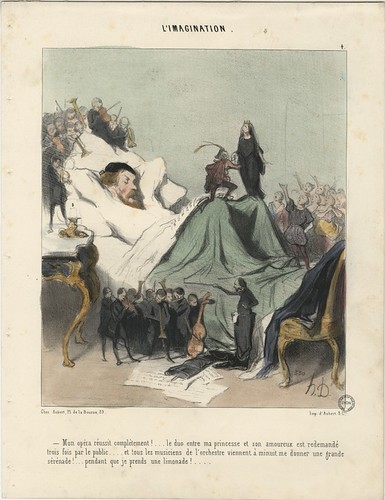
"- Mon opéra réussit complètement!... le duo entre ma princesse et son amoureux est redemandé trois fois par le public... et tous les musiciens de l'orchestre viennent à minuit me donner une grande sérénade!... pendant que je prends une limonade!...."
*- My opera will be a huge success... the duet between the princess and her lover will be repeated three times.... and all members of the orchestra will come at midnight to my place to give me a serenade.... while I'm having a lemonade!....* {approximation}
Published by Maison Aubert in 1844 [Artist - Honoré Daumier]
From a series of four prints, 'L'Imagination', that appeared in 'Le Charivari'.
The author of an opera is dreaming about the success of his new work. He sees the actors and the orchestra as small figures who are promising a successful opening.
Notes from the Brandeis Daumier collection; image sourced from BM de Lyon.

Soufflez, soufflez, vous ne l'eteindrez jamais
(Blow, blow, you'll never extinguish it)
Published by Maison Aubert in 1834 [Print made by JJ Grandville AND Honoré Daumier; printed by Bernard]
Satire on censorship; on the right a woman personifying France and Liberty is holding a torch upon which is inscribed with the word 'presse'; from an arched opening seven political figures, including D'Argout, Persil and Soult, are trying to put the torch out; above, a bat with a human head.
In the lower left corner of the lithograph, the initials of both Daumier and Grandville can be seen, making this illustration a particularly rare collaborative work by two of the greatest French illustrators of the 19th (or any) century. It's the equivalent of Gillray and Cruikshank combining forces.
The notes are derived from the British Museum database but the image -- a much brighter, larger and more legible version, that appears to be identical, including plate no., to the BM print -- was sourced from Centre de Recherche du Château de Versailles.
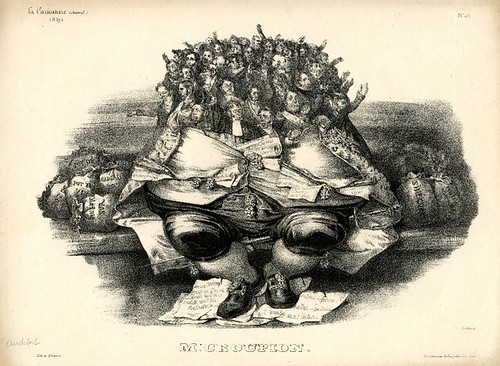
M[onsieur] Croupion
Published by Maison Aubert in 1831 in 'La Caricature' [Printmaker/artist unknown; printed by Delaporte]
A monstrous seated man (probably Louis-Philippe) with hundreds of figures emerging as his head (members of Parliament covered in honours and bribes). {'Croupion' translates as tail or rump}
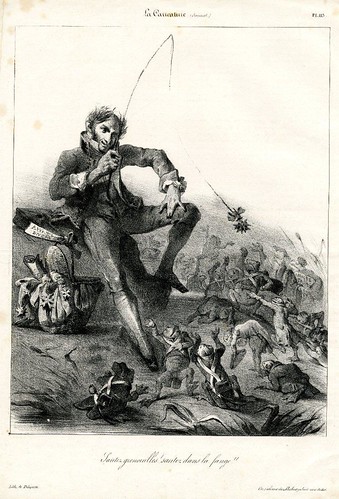
Sautez grenouilles! Sautez dans la fange!
(Jump frogs! Jump in the mud!)
Published by Maison Aubert in 1831 [Printmaker/artist unknown; printed by Delaporte]
Crowds of frogs dressed as Frenchmen jump as the cross of the Legion of Honour is dangled above them by a fisherman.

Eh! bien, mon cher Emile, vous en voila donc aussi coiffe!
(Ah! well my dear Emile, you're headed in there too! [*I think*]
(Ah, my dear Emile, you wear that hat too!)
Published by Maison Aubert. Undated but it must be at least late 1840s but more likely later [Artist: Charles Vernier]
Image source FAMSF
(see comments below)

Le Boucher des Pays-Bas
(The Dutch Butcher)
Published by Maison Aubert. Undated. [Print made by Henri Monnier; printed by Delaporte]
A butcher standing, in profile, his work clothing bloody, holding a butcher knife and putting the head of a man, kneeling, on a chopping block. {Image source: *I think* BM de Lyon}
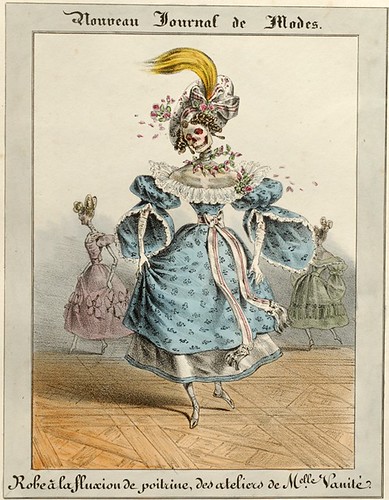
Robe à la Fluxion de Poitrine, des Ateliers de Mademoiselle Vanité
(The pneumonia dress from Miss Vanity's boutique)
Published by Maison Aubert in 1834 [Printmaker: Charles Philipon]
This print appears in a 2-volume caricature compilation set but was almost certainly produced prior to 1830 in a series by Philipon called 'Nouveau Journal de Modes'. [Image source]
[Except where stated, the images above were sourced from the estimable British Museum Prints database and many of the accompanying notes were paraphrased or quoted from their Curator's comments]
It may not be the first time that the skeleton of a foetus has appeared on this site in a relatively bizarre setting, - see Stuff of Life - but in the present case, the foetal image up top not only stopped me in my tracks because of its visual impact, but it also became the prime motivating agent behind this whole post. As I was to discover, it came from one of the most influential publishing houses of 19th century France.
Gabriel and Marie-Françoise Aubert suffered financial difficulties and moved to Paris at the invitation of Marie-Françoise's brother, Charles Philipon, an up and coming print artist and publishing entrepreneur. Together the three of them established La Maison Aubert at Le Place Véro-Dodat, in a fashionable Right Bank district, in December of 1829.
Essentially, Maison Aubert was a caricature emporium* and lithographer/publisher. Philipon was its Editor-in-Chief, sacrificing his own artistic career to assemble and actively lead a band of illustrators (Grandville, Daumier, Gavarni, Traviés, Benjamin etc) whose output appeared in the hugely influential and popular weekly and daily subscription magazines, 'La Caricature' [est. 1830] (more political) and 'Le Charivari' [est. 1832] (more social). These were the most famous publications ('Le Charivari' continued for more than 100 years) to come out of Maison Aubert (and for several years they were the only satirical journals published in Paris) but there was also a steady output of incidental prints and compilation series and they would eventually come to dominate the lithographic printing industry over the course of the 1830s and 1840s.
Although the creation of the business was well timed, coinciding with a relative flattening of the class structures of pre-revolutionary France, a limited relaxing of censorship rules and an increased awareness and appetite by the bourgeois Parisians for satirical political and social humour, the business was plagued by fines and staff imprisonment in the early years, as it fell foul of the political and royal authorities.
"In 1832, Philipon claimed to have suffered, "twenty seizures, six prosecutions, three convictions, over 6,000 francs in fines, 13 months of prison, and persecutions.” His publisher, Aubert, was prosecuted eight times between 1831 and 1834." [source]
- The Invention of Comics by Patricia Mainardi IN: 'Nineteenth Century Art Worldwide' [Vol. 6. Issue 1, 2007]
- Charles Philipon biography: Wikipedia; Art of the Print.
- Charles Philipon's La Caricature at Princeton's Graphic Arts blog.
- Daumier exhibition site at the BNF.
- 'Caricature and French Political Culture 1830-1848: Charles Philipon and the Illustrated Press', 2000, by DS Kerr.
- If anybody has access to Art Journal, see: 'Charles Philipon, La Maison Aubert, and the business of caricature in Paris, 1829-1841' by J Cuno, 1983 [Vol. 43, No 4, pp. 347-354]
- Thanks Karla.
- Yes, this post was essentially abandoned before finishing. Sometimes it's just time, you know?



















11 comments :
There are a couple of jokes that are not obvious. "Bâstard Foetus Hérédité" is an allusion to "Philippe égalité. That was a nickname ou the father of regning king. The nickname of the reigning king was simply "Égalité fils"
"bon fils, bon Pair", The word "pair" has excatly the same meaning as "peer" in english. "Pair"sonds exactly like the word "père" that is "father" in english. Consequently, "bon fils, bon Pair", means" good son, good peer" and also "good son, good father"
And Vous en voilà donc aussi coiffé refers not to where they are headed but the hats they are wearing : "You wear that hat, too" ; both wear bicornes, the hat of Napoleon.
Since you date the pictures as 1840s at least, it probably is linked to Louis Napoléon's election then imperial nomination.
Thanks and ouch! This is what happens when you combine schoolboy French and an online translator.
Linca, the artist (Vernier) was born in 1831. But of course the image design may have been older and may have been copied.
It seems the caricature dates from around 1866-7, and pictures Emile Ollivier (http://en.wikipedia.org/wiki/Emile_Ollivier, he clearly resembles his wiki picture) who at the time was moving from the opposition to Louis Napoléon's cabinet. Le Palais de l'Elysée being the French presidential (and at the time imperial) residency.
Aha, it's finally up! Very fine, it had been awhile since we had any fetuses-in-art. And you even managed to avoid using the famous king's-head-as-pear Philipon.
A couple of things: I'd disagree with your source about political caricature beginning around 1830. Political caricature and cartooning was big in the 18th century in both France and England. Or am I misinterpreting your reading of the source, which I haven't looked at yet?
Also, I am pretty sure that there was more than one French artist named Vernier. I have a vague recollection of discovering this not long ago, although I can't imagine why I was looking up Vernier. I believe I was looking for an earlier one than the one you mention. Then again, I may have dreamt it. Moving causes brain rot.
I just bought your book. Lots of fun! Congratulations.
Thanks The Clever Pup!
Karla, you're right to note that the quote at top is a little dubious, but I left it in because it kind summarised or set the scene well enough.
The distinction is that prior to the 1830s political caricatures were incidental one-offs produced by single print artists. With Maison Aubert, the genre became thematic and institutionalised, if that makes sense --- I think them calling it "popular" is code for this, but it's not as accurate as it could have been. And we are predominantly speaking about France on its own.
This is just one of the complicating factors (of which there were several complex types) that kind of defeated me: in other words, the full story requires some pretty in-depth analysis of the social, political, geographical history, print/lithograph history, reviews of alternative publications and a surveying of prints back to the mid-1700s ---- it was the weight of all this that caused me to run away. I'd merely wondered about the makers of the foetus satire and ended up knee deep in significant details. It's more in the way of a long form essay topic but to do it justice it would need 5000 words at least. And that wouldn't either be sufficiently detailed or cover the breadth of interconnected tropes.
The Vernier from here was born in 1831, of this I am 99.29% sure.
I'm all for learning more about the history of caricature. Let me know when you write an entire tome on it. (Admittedly, I do have a couple of books--somewhere--and some articles awaiting reading that might be informative.)
I believe the order would be...
The Hereditary Bastard Foetus Count d'...
Hereditary count being his title, and bastard foetus being the qualifier.
I just love your blog. Thank you for sharing all of these treasures with us.
'..bastard foetus being the qualifier'.
Now that's a phrase I'm going to have to add to my walk around lexicon!
I agree. In a world full of threadbare, boring expletives and insults, "bastard foetus" deserves a revival.
Post a Comment
Comments are all moderated so don't waste your time spamming: they will never show up.
If you include ANY links that aren't pertinent to the blog post or discussion they will be deleted and a rash will break out in your underwear.
Also: please play the ball and not the person.
Note: only a member of this blog may post a comment.